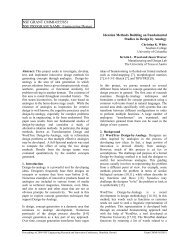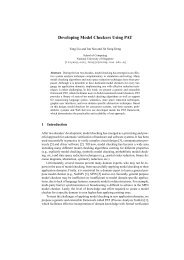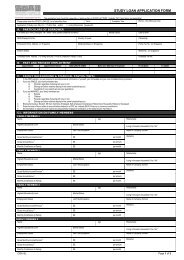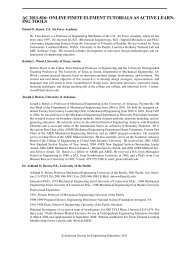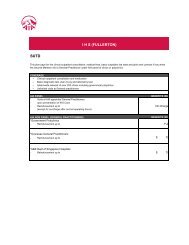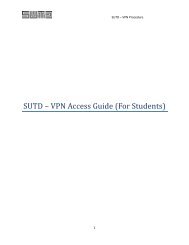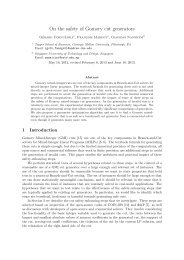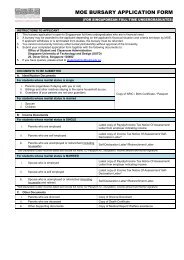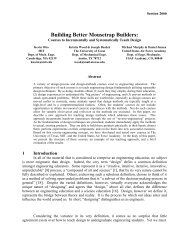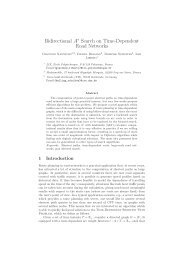Enzyme Kinetics Instructor Guide.pdf - MIT Teaching and Learning ...
Enzyme Kinetics Instructor Guide.pdf - MIT Teaching and Learning ...
Enzyme Kinetics Instructor Guide.pdf - MIT Teaching and Learning ...
You also want an ePaper? Increase the reach of your titles
YUMPU automatically turns print PDFs into web optimized ePapers that Google loves.
<strong>Enzyme</strong> <strong>Kinetics</strong><br />
Differential Equations Series<br />
<strong>Instructor</strong>’s <strong>Guide</strong><br />
Table of Contents<br />
Introduction . ................................. 2<br />
When to Use this Video . ..................... 2<br />
<strong>Learning</strong> Objectives . ........................ 2<br />
Motivation . ............................... 2<br />
Student Experience . ........................ 2<br />
Key Information . ........................... 2<br />
Video Highlights . .......................... 3<br />
Video Summary . ........................... 3<br />
Chem 101 Materials . ........................... 4<br />
Pre-Video Materials . ........................ 4<br />
Post-Video Materials . ....................... 5<br />
Resources Chem 101<br />
Intro<br />
Contents CONTENTS<br />
Additional Resources . .......................... 6<br />
Going Further . ............................ 6<br />
References . ............................... 7<br />
Appendix . ................................... A1<br />
Developed by the <strong>Teaching</strong> <strong>and</strong> <strong>Learning</strong> Laboratory at <strong>MIT</strong><br />
for the Singapore University of Technology <strong>and</strong> Design<br />
Differential Equations: <strong>Enzyme</strong> <strong>Kinetics</strong><br />
© 2012 <strong>MIT</strong><br />
Page 1<br />
+
Introduction<br />
When to Use this Video<br />
<br />
<br />
<strong>Learning</strong> Objectives<br />
In Chem 101, at home or in recitation, either<br />
before or after Lecture 36: More effects on<br />
reaction rates<br />
Prior knowledge: determining rate laws<br />
from experimental data, predicting rate laws<br />
from proposed reaction mechanisms, <strong>and</strong><br />
underst<strong>and</strong>ing the effect of catalysts on reaction<br />
rate<br />
After watching this video students will be able to:<br />
<br />
<br />
Motivation<br />
<br />
<br />
Explain how enzymes affect reaction rates.<br />
Derive a rate law for a general enzyme-catalyzed reaction.<br />
Key Information<br />
Duration: 18:38<br />
Narrator: Prof. Krystyn Van Vliet<br />
Materials Needed:<br />
<br />
<br />
The changing concentrations of species in a chemical reaction provides a nice context for<br />
students to practice writing differential equations. Even though students may not be able to<br />
solve the differential equations, underst<strong>and</strong>ing how to describe processes with differential<br />
equations is an important skill.<br />
Many chemistry textbooks invoke the steady-state approximation to simplify a system of<br />
differential equations without making it clear to the students what conditions need to be<br />
satisfied in order for the approximation to yield reasonable results. This video makes these<br />
conditions explicit.<br />
Resources Chem 101<br />
Intro INTRO<br />
Contents<br />
Student Experience<br />
It is highly recommended that the video is paused when prompted so that students are able to attempt the<br />
activities on their own <strong>and</strong> then check their solutions against the video.<br />
During the video, students will:<br />
<br />
<br />
<br />
Derive a rate law for an enzyme-catalyzed reaction.<br />
Consider the mathematics behind the steady-state approximation.<br />
Think about how a proposed rate law might reveal useful information about a reaction<br />
mechanism.<br />
Differential Equations: <strong>Enzyme</strong> <strong>Kinetics</strong><br />
© 2012 <strong>MIT</strong><br />
Page 2
Video Highlights<br />
This table outlines a collection of activities <strong>and</strong> important ideas from the video.<br />
Time Feature Comments<br />
1:50 Prof. Van Vliet discusses why it is<br />
important to study reactions catalyzed<br />
by enzymes.<br />
2:32 A short animation describes how<br />
enzyme inhibitors could help treat<br />
malaria.<br />
3:37 The main video content is outlined.<br />
4:06 Biochemical terms (e.g., substrate,<br />
enzyme) are reviewed.<br />
4:30 How do enzymes work<br />
7:36 Derivation of Michaelis-Menten<br />
equation begins.<br />
12:15 The justification for using the steadystate<br />
approximation is presented.<br />
Some industrial processes that utilize enzymes are<br />
mentioned.<br />
This example provides students with one example<br />
of why underst<strong>and</strong>ing enzyme kinetics can be<br />
beneficial.<br />
Numerical solutions for a system of differential<br />
equations are shown. The conditions where the<br />
steady-state approximation will hold are discussed.<br />
16:19 The malaria example is revisited. Students consider how kinetic data <strong>and</strong> a rate<br />
equation might help them underst<strong>and</strong> how a<br />
enzyme inhibitor works.<br />
Resources Chem 101<br />
Intro INTRO<br />
Contents<br />
Video Summary<br />
Prof. Krystyn Van Vliet discusses the importance <strong>and</strong> utility of enzyme kinetics for drug<br />
development. Alongside the video, students derive a rate equation (the Michaelis-Menten equation)<br />
for a simple enzyme-substrate system. Returning to the drug development example, students see that<br />
rate equations can help them infer information about reaction mechanisms.<br />
Differential Equations: <strong>Enzyme</strong> <strong>Kinetics</strong><br />
© 2012 <strong>MIT</strong><br />
Page 3
Chem 101 Materials<br />
Pre-Video Materials<br />
When appropriate, this guide is accompanied by additional materials to aid in the delivery of some of the<br />
following activities <strong>and</strong> discussions.<br />
1. Elementary reactions <strong>and</strong> equilibrium (Appendix A1)<br />
This clicker question is from the learnChemE website (www.learncheme.com), developed by the<br />
University of Colorado, Boulder, Department of Chemical <strong>and</strong> Biological Engineering.<br />
This question requires students to combine their knowledge of chemical equilibrium <strong>and</strong><br />
elementary reactions. At equilibrium, the forward <strong>and</strong> reverse rates are equal. Since these are<br />
elementary reactions <strong>and</strong> thus first order in both directions, the rate constant of the forward<br />
reaction must be larger since the concentration of reactant G is much smaller than the<br />
concentration of product P.<br />
2. Rate laws from experimental data (Appendix A2)<br />
Have students derive the rate law from the given data. This should be a review for students.<br />
3. Reaction mechanisms<br />
Ask students if this mechanism<br />
Resources Chem CHEM 101<br />
Intro<br />
Contents<br />
is consistent with the rate law that they derived in the previous problem. Have students discuss<br />
which step might be rate determining. Why do they think so<br />
4. Catalysis<br />
In small groups, have students discuss how a catalyst increases the rate of a reaction. Then, have<br />
students discuss whether or not a given reaction would have the same rate law in a catalyzed<br />
<strong>and</strong> uncatalyzed case. Students should explain their reasoning.<br />
This question highlights the point that catalysts provide a different reaction pathway. Thus, the<br />
rate law would change because the reaction mechanism has changed.<br />
Differential Equations: <strong>Enzyme</strong> <strong>Kinetics</strong><br />
© 2012 <strong>MIT</strong><br />
Page 4
Post-Video Materials<br />
1. <strong>Enzyme</strong>-catalyzed reactions (Appendix A3)<br />
Use this question to emphasize that enzymes, like synthetic catalysts, do not influence the<br />
thermodynamics of a reaction.<br />
2. Competitive <strong>and</strong> noncompetitive inhibition (Appendix A4-A6)<br />
At the end of the video, a scenario is presented where a drug c<strong>and</strong>idate is shown to decrease<br />
the apparent v max<br />
of one of the proteases used by the malaria parasite to degrade hemoglobin.<br />
Two possible reaction mechanisms are proposed — competitive inhibition <strong>and</strong> noncompetitive<br />
inhibition. Have students derive a rate law from these mechanisms. Which rate law is supported<br />
by the data presented at the end of the video (replicated on page A4)<br />
3. If you have not done so already, introduce students to Lineweaver-Burk, Eadie-Hofstee, <strong>and</strong><br />
Hanes-Woolf plots. What would a Lineweaver-Burk plot look like for a case of competitive<br />
inhibition, compared to the control What would a Lineweaver-Burk plot look like for a case of<br />
noncompetitive inhibition, compared to control<br />
Resources Chem CHEM 101<br />
Intro<br />
Contents<br />
Differential Equations: <strong>Enzyme</strong> <strong>Kinetics</strong><br />
© 2012 <strong>MIT</strong><br />
Page 5
Additional Resources<br />
Going Further<br />
Biochemistry<br />
The video discusses the use of enzyme inhibitors in the treatment of disease. Systematically designed<br />
competitive inhibitors can also be used to probe the geometry <strong>and</strong> chemical reactivity of the active site<br />
of an enzyme. This information, combined with information from X-ray crystallography <strong>and</strong> other<br />
experimental techniques, can lead to better underst<strong>and</strong>ing of enzyme chemistry <strong>and</strong> reaction mechanisms.<br />
Kinetic experiments can also be used as a diagnostic to detect changes in physiological concentrations or<br />
activities of enzyme which might be indicative of disease.<br />
Biochemical Engineering<br />
An underst<strong>and</strong>ing of enzyme kinetics <strong>and</strong> the ability to formulate a rate law is essential for the modeling,<br />
design, <strong>and</strong> development of industrial processes that employ biocatalysts. In the design of these systems,<br />
conditions which may denature the enzyme will have to be considered. Temperature, exposure to<br />
mechanical forces, <strong>and</strong> the chemical environment (including pH) will have to be carefully considered.<br />
Rate data in the presence of possible denaturing conditions may need to be collected in order to more<br />
accurately predict substrate conversion.<br />
Resources RESOURCES Chem 101<br />
Intro<br />
Contents<br />
Differential Equations: <strong>Enzyme</strong> <strong>Kinetics</strong><br />
© 2012 <strong>MIT</strong><br />
Page 6
References<br />
The following chemical education articles discuss the motivation for <strong>and</strong> difficulties with teaching<br />
chemical kinetics.<br />
<br />
<br />
<br />
Campbell, J. A. (1984). <strong>Kinetics</strong>–Rates <strong>and</strong> Mechanisms. Journal of Chemical Education.<br />
61(1), 40-42.<br />
Justi, R. (2002). <strong>Teaching</strong> <strong>and</strong> <strong>Learning</strong> Chemical <strong>Kinetics</strong>. In J. Gilbert, O. Jong, R. Justi,<br />
D. Treagust & J. Van Driel (Eds.), Chemical Education: Towards Research-based Practice.<br />
Dordrecht, The Netherl<strong>and</strong>s: Kluwer Academic Publishers<br />
Lamb, W. G. (1984). Why Teach <strong>Kinetics</strong> to High School Students. Journal of Chemical<br />
Education. 61(1), 40-41.<br />
The following <strong>MIT</strong> Open CourseWare lectures address enzyme kinetics.<br />
<br />
Drennan, Catherine, <strong>and</strong> Elizabeth Vogel Taylor. 5.111 Principles of Chemical Science, Fall<br />
2008. (Massachusetts Institute of Technology: <strong>MIT</strong> OpenCourseWare), <br />
(Accessed 12 Mar, 2012). License: Creative Commons BY-NC-SA<br />
–Video Lecture #35 discusses <strong>Enzyme</strong> <strong>Kinetics</strong>. Also see the Biology Related Example for<br />
Lecture #35, linked to from the 5.111 homepage of OCW<br />
Nelson, Keith A., <strong>and</strong> Moungi Bawendi. 5.60 Thermodynamics , Spring 2008.<br />
(Massachusetts Institute of Technology: <strong>MIT</strong> OpenCourseWare), <br />
(Accessed 22 Mar, 2012). License: Creative Commons BY-NC-SA<br />
-Video Lecture #35 discusses <strong>Enzyme</strong> catalysis<br />
The following textbook addresses the topic of enzyme catalysis from a biochemical engineering<br />
perspective.<br />
<br />
Bailey, J. E., <strong>and</strong> D. F. Ollis. (1986). Biochemical Engineering Fundamentals. (2nd ed.). New<br />
York, NY: McGraw-Hill.<br />
Resources RESOURCES Chem 101<br />
Intro<br />
Contents<br />
Differential Equations: <strong>Enzyme</strong> <strong>Kinetics</strong><br />
© 2012 <strong>MIT</strong><br />
Page 7
Consider the following elementary reaction:<br />
k F<br />
G P<br />
k R<br />
At equilibrium, C G = 0.1 mol/L <strong>and</strong> C P = 2 mol/L.<br />
Which rate constant is larger<br />
A. k F (forward rate constant)<br />
B. k R (reverse rate constant)<br />
C. k F = k R<br />
D. Cannot be determined<br />
!"#$%&'($)*+%#$%,-*.%/"(%0(1-+2"(.3%4(5$#/(%644470(1-+8"(.(78*.9:%;(%/"(%+#%*,%2*0*-1;*:%@*'0;(-%<br />
A(=1-/.(+/%*,%2"(.#810%1+;%@#*0*B#810%3+B#+((-#+B7%<br />
Elementary reactions <strong>and</strong> equilibrium<br />
Page A1
D,/6'95'6,-'./6-'*/4E'<br />
+,-'.-/0123'<br />
!"#$%&'(')* ! $%&'' !"#)*'$%&'<br />
4/5'56789-8'/6':;< 2 )='+,-'>2**2493%'8/6/'4-.-'26/93-8'4,-.-'<br />
Rate = " #[Cl ] 2<br />
#t<br />
!"#$ % &'()*+,-& !.*$ % &'()*+,-& /0123*&4356&'()*+,&<br />
(10-&<br />
!<br />
D,90,'2>'6,-'>2**2493%'95'"#+'0,/3%-8'93'<br />
/3'-3FGH-'0/6/*GF-8'.-/0123E'<br />
/= +,-'-I79*9.97H'02356/36J'K'<br />
= +,-'./6-'2>'.-/0123'<br />
0= +,-'.-/0123'H-0,/395H'<br />
8= +,-'./6-'*/4'<br />
<strong>Enzyme</strong>-catalyzed reactions Page A3
K93-10'L/6/')2**-0123'<br />
Q < ' $8.7%&'<br />
R < '<br />
< H/T '<br />
< H/T U'<br />
S-/0123'./6-'<br />
M/.G93%'NOP'$,-H2%*293&'<br />
O756./6-'0230-36./123'<br />
Competitive <strong>and</strong> Noncompetitive Inhibition<br />
Page A4
)2HV-11M-'Q3,99123'<br />
7&<br />
R3FGH-' R3FGH-'<br />
/&<br />
R'('O'' RO''<br />
R'('Q'' RQ''<br />
R3FGH-'<br />
RO'' R'('W''<br />
/& X'93,9962.'$8.7%&'<br />
Competitive <strong>and</strong> Noncompetitive Inhibition<br />
Page A5
"2302HV-11M-'Q3,99123''<br />
7&<br />
R3FGH-' R3FGH-'<br />
7&<br />
R3FGH-'<br />
R3FGH-'<br />
R'('O'' RO''<br />
RQ'('O'' ROQ''<br />
RO'('Q'' ROQ''<br />
RO'' R'('W''<br />
Competitive <strong>and</strong> Noncompetitive Inhibition<br />
Page A6



